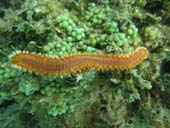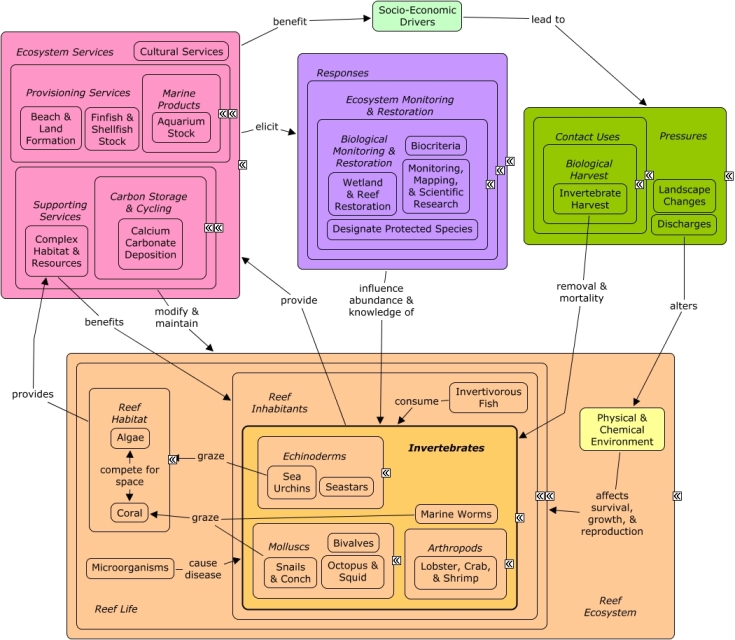ReefLink Database

Marine Worms
Any worm that lives in a marine environment is considered a marine worm. Some marine worms such as the hermodice, or "fireworm" feed on stony coral. Many other marine worms, such as polychaetes and flatworms, make their homes in coral reefs, and are the prey of fish, are thus a valuable part of the ecosystem.
CMap

CMap Description
The community of marine worms encompasses many animal phyla and fulfills various functions on a coral reef. All species are important to the cultural services of coral reefs. Some marine worms graze the coral surface and others build their homes in coral rock for protection; all using the complex habitat & resources provided by the reef habitat. Marine worms provide a trophic link in the food web as they are consumed by other marine species. Socio-economic drivers lead to the removal & mortality of marine worms through harvesting pressures; also, the survival, growth, and reproduction of marine worms are reduced by disease-causing microorganisms and a disturbed physical & chemical environment. Biological monitoring, mapping, and restoration is needed to identify changes in the abundance and condition of marine worms; and ultimately, determine the appropriate responses to maintain the supply of ecosystem services and ensure the benefits to human health and well-being.Citations
More than 50 citations. Click here to load.
| Citation | Year | Study Location | Study Type | Database Topics |
|---|
Management Options
| Management Option | Description | Sources | Database Topics |
|---|---|---|---|
| Monitor & Research: Biological Status and Trends Monitoring | This activity produces long-term comprehensive information on sanctuary-wide status and trends of biological resources. Data that could be collected on coral reef communities includes but is not limited to species abundance and density, biodiversity, benthic cover, coral condition, growth, recruitment, predation, and grazing. Mangroves and seagrasses should also be monitored. With adequate baseline data, changes in community structure and biocriteria can be identified and restoration or protection efforts can be taken. | NOAA Marine Sanctuary Program. 2007. Florida Keys National Marine Sanctuary revised management plan. National Ocean Service, Key West, FL. |
Algae; Anemones & Zooanthids; Apex Fish Predators; Aquaculture; Aquarium Stock; Biochemical & Genetic Resources; Biocriteria; Biological Harvest; Biological Monitoring & Restoration; Biological Monitoring, Mapping, & Scientific Research; Bivalves; Calcareous Macroalgae; Contact Uses; Coral; Coralline Algae; Cyanobacteria; Decision Support; Echinoderms; Ecosystem Monitoring & Restoration; Finfish & Shellfish Stock; Fish; Fishing Sector; Food & Energy Policies; Hydrocoral; Invasive Species; Invertebrates; Large Herbivorous Fish; Lobster, Crab, & Shrimp; Mangroves; Marine Birds; Marine Products; Marine Vertebrates; Marine Worms; Microorganisms; Molluscs; Octocoral; Octopus & Squid; Ornamental Jewelry & Art; Pathogens; Pharmaceuticals & Cosmetics Sources; Physical Damage; Primary Production; Provisioning Services; Resource Use Management; Sea Turtles; Sea Urchins; Seagrasses; Seastars; Skeletal Coral; Small Herbivorous Fish; Snails & Conch; Sponges; Stony Coral; Tunicates; Wetlands; Whales & Dolphins |
Laws
| Legal Citation | Purpose of Law | Management Organization | Database Topics |
|---|
